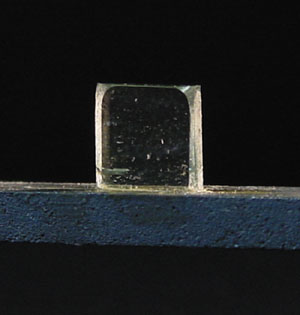
End Station A, the venerable fixed-target facility at the end of the two mile electron linear accelerator beam at SLAC, Stanford, where quarks were discovered in 1967, will soon see a high-energy beam of polarized (spin oriented) photons as three newly approved experiments move onto the floor.
An international collaboration led by Peter Bosted and Stephen Rock (Massachusetts), Donald Crabb (Virginia) and Keith Griffioen (William and Mary) will use paper-thin diamond wafers to generate coherent photon beams with energies of up to 48 GeV.
Louis Osborne and Roy Schwitters pioneered this technique at SLAC in 1970, when the maximum electron energy was 20 GeV. Specific crystal planes of the diamond are precisely aligned with the electron beam to create a diffraction grating for the bremsstrahlung photons produced by electrons interacting in the crystal. This process yields distinct spikes in the photon energy spectrum. Small-angle collimation then enhances the ratio of coherent to incoherent radiation. SLAC’s highly polarized electron beam, with energies now as high as 50 GeV, will be used to generate more than a billion circularly polarized photons per second.
The three new experiments are known as E159, E160 and E161. E161 will study the contribution of gluons to the spin of nucleons. Since the 1980s, Lepton-nucleon scattering experiments at CERN, SLAC and DESY have established that the constituent quarks are responsible for only 25 per cent of the nucleon’s spin. The rest must come from the orbital motion of quarks and gluons and from the intrinsic spin of the gluons.
E161 will study gluon contributions to nucleon spin via a photon-gluon fusion process, in which a circularly polarized photon merges with a polarized gluon to form an unbound charm-anticharm quark pair. The production of charm quarks is established via their decay to muons, which will be identified using a long dipole magnet filled with alumina. Polarized LiD will be used as the target, cooled to 300 mK with a dilution refrigerator inherited from CERN.
E160 will measure the dependence of J/psi production on nuclear composition by firing unpolarized photons at several different unpolarized nuclear targets. This experiment will aid searches for the quark-gluon plasma at CERN’s SPS (Super Proton Synchrotron) and Brookhaven’s RHIC (Relativistic Heavy Ion Collider), in which one expected signature is the suppression of J/psi production. A better understanding of the simpler photoproduction process should help to interpret those results.
E159 will test the Gerasimov-Drell-Hearn sum rule using polarized photons and polarized ammonia and ND3 targets. In this sum rule, the difference between the total cross-sections with the photon spin-polarized parallel versus antiparallel to the nucleon spin is related to the anomalous magnetic moment of the nucleon. If this prediction is not verified, it could suggest possible excitations of the nucleon not previously identified – or even new particles or interactions not encompassed by the Standard Model.
At the heart of all three experiments lie diamonds and charm. Once beautifully set to show their best facets to the electron beam, these diamonds will indeed become a physicist’s best friend.







